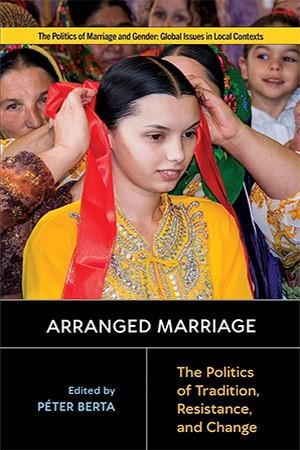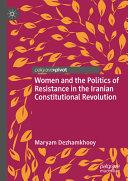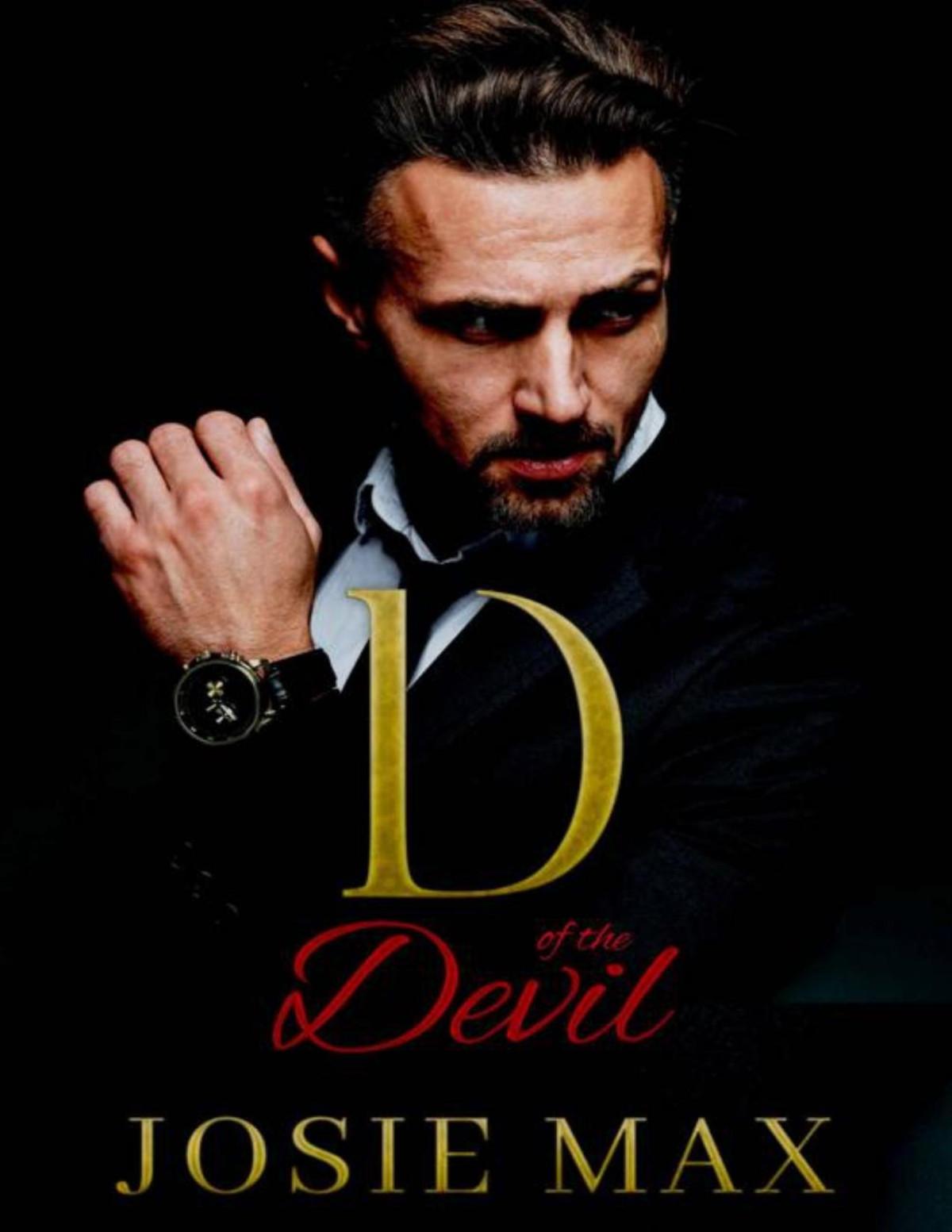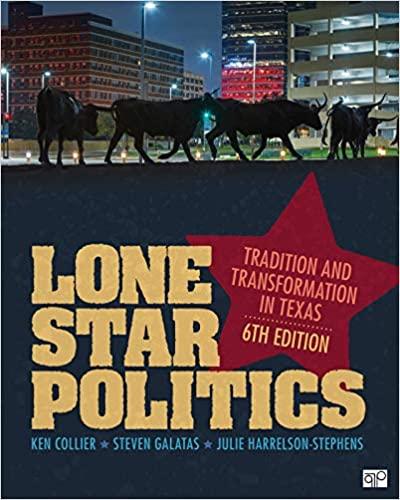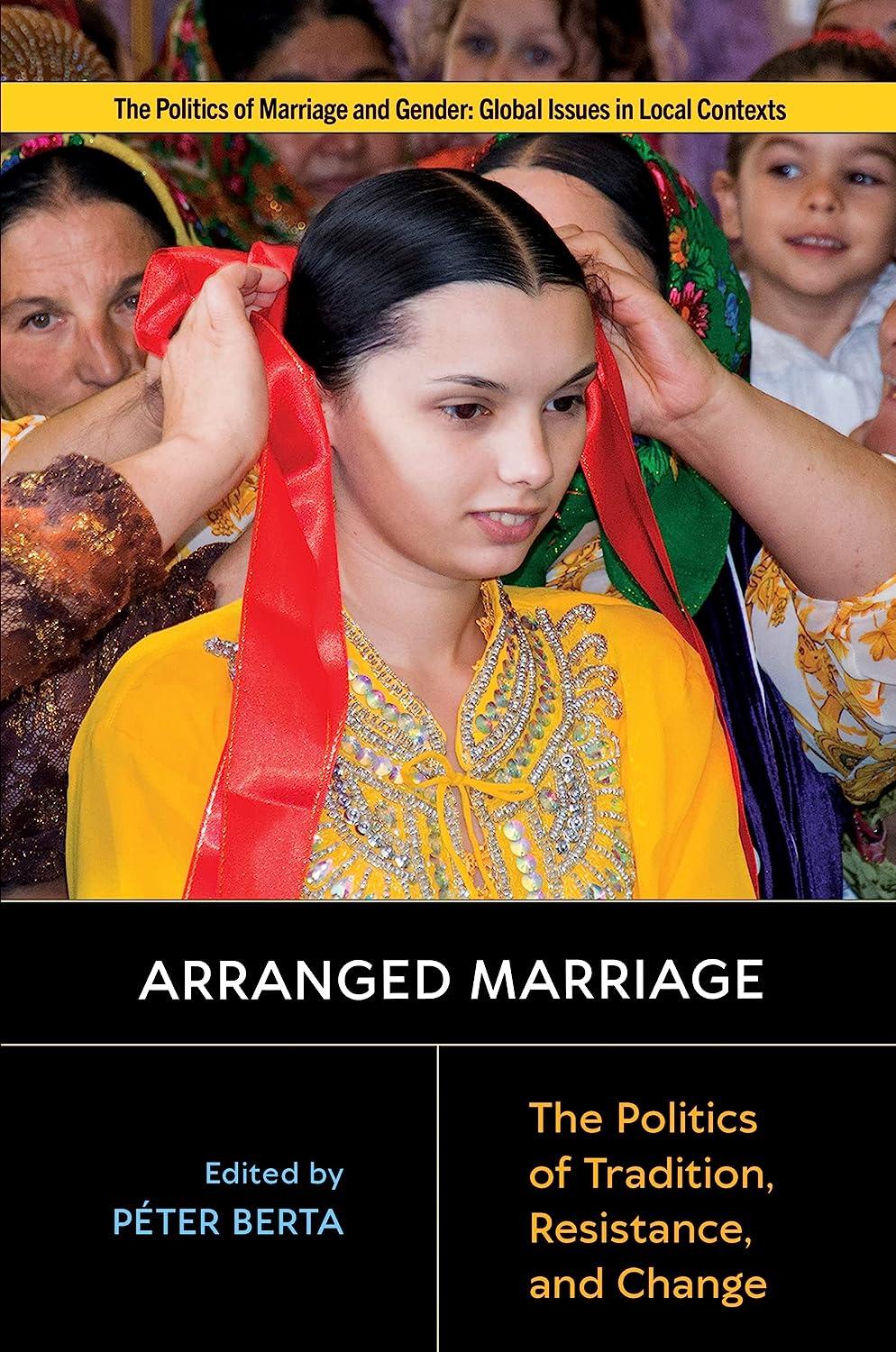Arranged Marriage
The Politics of Tradition, Re sis tance, and Change
EDITED BY P É TER BERTA
NEW
RUTGERS UNIVERSITY PRESS
BRUNSWICK, CAMDEN, AND NEWARK, NEW JERSEY
LONDON
AND OXFORD
Rutgers University Press is a department of Rutgers, The State University of New Jersey, one of the leading public research universities in the nation. By publishing worldwide, it furthers the University’s mission of dedication to excellence in teaching, scholarship, research, and clinical care.
LIBRARY OF CONGRESS CATALOGING-IN-PUBLICATION DATA
Names: Berta, Péter, 1972 editor.
Title: Arranged marriage : the politics of tradition, resistance, and change / edited by Péter Berta.
Description: New Brunswick, New Jersey : Rutgers University Press, [2023] | Series: Politics of marriage and gender: global issues in local contexts | Includes bibliographical references and index.
Identifiers: LCCN 2022025186 | ISBN 9781978822825 (paperback ; alk. paper) | ISBN 9781978822832 (hardcover ; alk. paper) | ISBN 9781978822849 (epub) | ISBN 9781978822863 (pdf)
Subjects: LCSH: Arranged marriage.
Classification: LCC HQ802 .A77 2023 | DDC 306.81—dc23/eng/20220621
LC record available at https://lccn.loc.gov/2022025186
A British CataloginginP ublication record for this book is available from the British Library.
This collection copyright © 2023 by Rutgers, The State University of New Jersey Individual chapters copyright © 2023 in the names of their authors
All rights reserved
No part of this book may be reproduced or utilized in any form or by any means, electronic or mechanical, or by any information storage and retrieval system, without written permission from the publisher. Please contact Rutgers University Press, 106 Somerset Street, New Brunswick, NJ 08901. The only exception to this prohibition is “fair use” as defined by U.S. copyright law.
References to internet websites (URLs) were accurate at the time of writing. Neither the author nor Rutgers University Press is responsible for URLs that may have expired or changed since the manuscript was prepared.
rutgersuniversitypress org
CONTENTS
Series Foreword ix
P É TER BERTA
Introduction: Conceptualizing Arranged Marriage –From Binary Oppositions to Hybridity, Processuality, and Contextual Dependency 1
PÉTER BERTA
PART ONE Regulating Arranged Marriage
1 Nothing “Celestial” about It: Trafficking Underage Brides between Canada and the United States for the Purposes of Arranged Marriage 33
SERENA PETRELLA
2 From Family Safety Net to the World Wide Web of Immigration Fraudsters: The Evolution of Arranged Marriages among South Asian Canadians 48
NOORFARAH MERALI
PART TWO (Re)conceptualizing Arranged Marriage
3 A rranged Marriage as a Process: From Premarital Normalization of Arranged Marriage to Arranged Divorce and Arranged Remarriage 67
PÉTER BERTA
4 C onfiguring Arranged Marriage as a Foil to Forced Marriage in Multicultural Australia 91
HELENA ZEWERI
5 Forced Marriage and “Honor”-Based Violence in Britain: Issues, Debates, and the Question of Consent 108
CHRISTINA JULIOS
PART THREE
Revitalizing and Reinventing Arranged Marriage
6 Revisiting Transnational Arranged Marriages among Syrian Refugees in Germany: A Relational Approach
YAFA SHANNEIK AND SCHIRIN VAHLE
7 From Patriarchal Call to Digital Hunt: Transforming “Arranged Marriages” in China 141
PAN WANG
PART FOUR
Modernizing Arranged Marriage
8 Family-A rranged Marriages in Globalizing India: Shifting Scripts of Desire, Infidelity, and Emotional Compatibility 159
SHALINI GROVER
9 P rogressive Traditions, Repressive Victorians, and the Modern Present: Arranged Marriage and Gender in Sri Lanka 175
ASHA L. ABEYASEKERA
10 “I Wanted to Choose for Myself”: Changing Marriage Patterns in the Ultra-Orthodox Society in Israel
SIMA
ZALCBERG BLOCK
PART FIVE
Diasporizing Arranged Marriage
11 Wedded to Tradition? Continuity and Change in Arranged Marriage Practices among British Indians
RAKSHA PANDE
FARHA TERNIKAR
A fterword
MARIAN AGUIAR
Acknowledgments
Arranged Marriage
Advanced Praise for Arranged Marriage
“The collection highlights the blurred lines between arranged and forced marriages, on the one hand, and arranged and ‘love’ marriages, on the other hand. It underlines the dynamics of these marriages, both historically, over time, and processually, in time, through evocative and sensitively documented case studies, each essay stressing the evolving relations between individual agency, gender, generation, and power in changing economic, technological, and demographic circumstances. Many of the case studies are surprising and thoughtprovoking, and the remarkable achievement in bringing them all together in a single volume is to underline both the similarities and differences in familial relations across the world.”
P nina Werbner, professor emerita in social anthropology
at Keele University
“Arranged marriage is unhooked from its stereot ypes and stigmas in this volume. What we get instead are new and unexpected insights into an enduring, flexible, portable, and hybrid mode of heterosexual conjugality. An excellent scholarly and pedagogical tool!”
Jyoti Puri, Hazel Dick Leonard Chair and professor of sociology at Simmons University
“This thoughtful collection of essays reveals deep variation in the lived experiences of arranged marriage in today’s border crossing world. A valuable contribution to scholarship on the politics of marriage and the diverse meanings of choice, consent, love, and intimacy.”
Sara L. Friedman, professor of anthropology at Indiana University
“This book offers fresh perspectives on contemporary practices of arranged marriage, and as such should be regarded as a pioneering work. In par ticular, it makes an impor tant new contribution by exploring where, how, and with what consequences arranged marriage practices intersect with rightsbased discourses about forced marriage and child marriage—that is, with state concerns to prevent human trafficking and to protect women and children from sexual exploitation. As this book shows, arranged marriage is thriving, in fluid and flexible contemporary forms, embedded in processes of transnational migration, modernization, and the sustaining of ethnic, national, and religious differences.”
A lison Shaw, professor of social anthropology at the University of Oxford
“EuroA merican discourse on marriage in diasporic communities often becomes hopelessly entangled in the supposed binary relationship between arranged and love marriage. This book does an excellent job of exploring the fluidity of marital arrangements and the agency individuals exercise within the patriarchal constraints without losing sight of the coercion and violence that might underlie some of these arrangements.”
Sonalde Desai, distinguished university professor of sociology at the University of Maryland
“As a set of practices that are constantly mutating and notoriously difficult to pindown statistically, arranged marriages have aroused much interest, debate, and judgment in scholarly, feminist, and activist circles. The present volume of thoroughly researched and sharply analyzed essays offers a global view of this complex institution that helps the reader to develop a dynamic understanding of arranged marriage practices, departing from received notions. A mustread for anyone interested in the contemporary real ity of a deep historical practice.”
Rochona Majumdar, professor of South Asian languages and civilizations at the University of Chicago
“Arranged Marriage is a compelling collection that forces readers to rethink their assumptions about love, marriage, and choice. Although ‘modern’ is a word rarely associated with such unions, this volume persuasively demonstrates that these marriages are not an outdated relic of the past. By providing a thoughtful and nuanced picture of this ageold practice, Arranged Marriage leaves it up to the reader to decide whether the good outweighs the bad.”
Marcia Zug, Miles and Ann Loadholt Professor of Family Law at the University of South Carolina
“Highlighting processual and contextual understandings of arranged marriage, and a deessentializing approach, this timely collection shows the continued vibrancy, versatility, and variability of current arranged marriage practices— a nd their crucial importance for studies of marriage and relationality.”
Janet Carsten, professor of social and cultural anthropology at the University of Edinburgh
“Berta’s edited volume is a deep dive into the nuances of the varied processes of arranged marriages—f rom lovechoice to trafficking. Each chapter reads like a novel, taking us through rich collections of stories grounded in ethnography and legal records in communities as diverse as Canadian Mormons, Israelis, Chinese, South Asians, Roma, and Syrian refugees. I look forward to the debates with my students.”
Erin Patrice Moore, professor of anthropology at the University of Southern California
“This volume interrogates arranged marriage in all its complexities and ambiguities across the globe. It illuminates how migration, legal institutions, technology, and transnational cultural flows interweave with shifting marital practices in Europe, North Amer ica, the M iddle East, South Asia, and Australia.”
Keera Allendorf, associate professor of sociology and international studies at Indiana University
“This comprehensive approach to arranged marriage looks both at the dark side of arranged marriages, where women are treated as objects and vulnerable to severe exploitation, and a more nuanced look from a global perspective on how arranged marriage can suit the needs of dif ferent populations around the world. There is a high level of scholarship among the invited authors for this book of curated articles and it is hard to imagine anyone who is interested in arranged marriage not needing this book.”
Pepper Schwartz, professor of sociology at the University of Washington
“This valuable collection shows both the diversity of arranged marriages, and the manner in which the practice has changed globally to adapt to current social, economic, pol itical, and media settings. The authors refute the simplistic binary between ‘arranged’ and ‘love’ marriages in contemporary societies. The volume also sheds light on forced marriages and how a marriage which might seem consensual may not be so. Must reading for scholars of marriage studies anywhere.”
Janet Afary, professor and Melchamp Chair in Global Religion at the University of California, Santa Barbara
Introduction
Conceptualizing Arranged Marriage – From Binary Oppositions to Hybridity, Pro cessuality, and Contextual De pen dency
P É TER BERTA
Quantifying Arranged Marriages: Statistical Invisibility, Performative Diversity, and Definitional Proliferation
Like the great majority of social scientists, researchers dealing with the c auses, dynamics, and consequences of the transformations of marriage and family life are often forced to demonstrate the unquestionable significance of the practices they study and the timeliness of their investigation—for example, in the context of “tournaments of value” (Appadurai 1986: 21) waged for publication in highimpact factor journals or for teaching posts in prestigious universities. One of the techniques often used for the strategic demonstration of relevance is to focus on the extensive spread of the practices studied, that is, their quantification. However, primarily due to the lack of reliable databases, this poses a big challenge for researchers of arranged marriages and often proves to be an insoluble task (Aguiar 2018; Allendorf and Pandian 2016; Clawson and Fyson 2017; Julios 2015 and chapter 5 of this book; Marcus et al. 2019; Samad 2010).
For this reason, many analyses of the social, cultural, economic, and political causes and consequences of arranged marriage either refrain from the quantification of this practice or give subjective estimates emphasizing the (global or regional) spread of arranged marriage. These estimates are generally very brief, often vague, and sketchy, supported (if at all) mostly by findings obtained from research using qualitative methods with a usually narrow (for example, local or regional) geographical focus, or by the estimates of other authors. To cite only a few examples of statements falling into this category: “arranged marriages have existed for millennia, and are widely instituted among many cultures around the world” (Bowman and Dollahite 2013: 207); “most of the world’s marriages are arranged by parents and matchmakers” (Epstein et al. 2013: 341); “arranged marriages between adult
men and young girls traditionally occur in Africa, Southeast Asia, the Near East, and Latin America” (Soliman et al. 2018: 125); or “arranged marriages so defined remain typical for large parts of the world like India, Pakistan, and Bangladesh” (Munshi 2017: 36). (See also Batabyal 2001: 273; Chawla 2007: 5; Gupta et al. 2016: 75; Myers et al. 2005; Singh et al. 2016: 243; and others.) Penn even argues that “arranged marriages . . . remain typical for around half the world’s population.” He hypothesizes that the number of arranged marriages w ill increase globally, “since they predominate in countries with high rates of population growth” (Penn 2011: 637).
Since there have been only very few surveys focusing— among other things—on arranged marriage (see, for example, the Indian Human Development Survey 2004–2005, 2011–2012 or the 2013 Taj Wedding Barometer Survey), one can rarely find research reports (a) that are based primarily on surveys or (b) that contain not only subjective estimates and findings drawn from qualitative ethnographic studies but also make emphatic use of surveys in quantifying arranged marriages. (See, for example, Allendorf 2013; Ghimire et al. 2006; González 2013; Malhotra 1991; Meekers 1995; Nedoluzhko and Agadjanian 2015; Xiaohe and Whyte 1990; Zang 2008.)
There have also been attempts at quantification based on unique logic. Aguiar (2018: 3), for example, in her fascinating book on how the meaning of arranged marriage has been continuously reinvented in the South Asian diaspora in Great Britain, the United States, and Canada, draws conclusions about change in the popularity of arranged marriage not on the basis of documented or presumed numbers of arranged marriage cases but instead on more reliably quantifiable discursive representations of arranged marriage. Her examination of references to arranged marriage in major newspapers—that is, the quantification of textual representations of the phenomenon— enabled Aguiar to draw sound conclusions regarding the dynamics of social interest surrounding arranged marriage as well as on the transformations and changing intensity of its discursive presence:
It is clear that arranged marriage exists in the diaspora, but it is difficult to say whether the number of arranged marriages is increasing or even holding steady in this context. No major empirical studies have been published quantifying conjugal choices in the diaspora. A lthough one cannot claim that there has been an increase in the number of arranged marriages, one can safely assert that the discourses concerning the concept and practice of arranged marriage have multiplied and taken on significant roles and done so globally. (Aguiar 2018: 3)
Numerous studies examining forced marriage mention the methodological and empirical difficulties in attempts to quantify the practice.1 Samad (2010: 195), for example, in his pathbreaking study investigating forced marriages among men, notes that in its quantification of the phenomenon, the Home Office Working Group on Forced Marriage in 1999–2000 “examined a number of sources available w ithout success. In the absence of a definitive figure it simply took the supposition that one case was one too many.” Samad adds that the research
he directed in 2001 (see Samad and Eade 2003), focused on the perceptions of forced marriages in the Pakistani and Bangladeshi communities, was also “unable to arrive at any conclusive figure,” in the same way that the attempt at quantification made in 2008 by the research team of Hester et al. also failed due to “the lack of accurate data.” Hester et al.
examined 29 databases, including those held by police and those held by organ i zations in the voluntary sector. It emerged that there was inconsistency in the way data were recorded, the categories used and the number of times the same individual was recorded on dif ferent databases. Hence it was not clear whether these were the same cases dealt with by dif ferent agencies or were separate cases and there was no evidence to prove or disprove speculation in the media that the problem may be as large as a thousand cases a year. (Samad 2010: 195)
On the basis of the annual number of forced marriage cases handled by the Forced Marriage Unit (founded in 2006 by an act of the British Parliament), the Community Liaison Unit at the Foreign and Commonwealth Office, the Southall Black Sisters, and the Bradford Police, Samad (2010: 195–196) fi nally reached the conclusion that “the only thing that can be confidently said about numbers is that the numbers of cases recorded have increased considerably.”
In her insightful chapter examining cases in Great Britain of forced marriage interpreted as part of honorbased violence (HBV) (see chapter 5 of this book), Christina Julios also discusses in detail the methodological challenges involved in quantification:
Given the hidden nature of HBV and the lack of standardized reliable data, it is not feasible to fully ascertain the scale of the problem. The work therefore must rely on “flawed” data, mostly featuring underestimates of what is believed to be a much larger problem. . . . Without a national centralized system of data collection and analysis, the United Kingdom’s information gap continues to be filled by a combination of government and law enforcement agencies, grassroots ser v ice providers, and academic institutions, among others. A s a result, the data are not entirely reliable and are generally believed to reflect only a small part of a much larger whole.
Marcus et al. (2019) report a similar experience in their overview of empirical analyses of forced marriage in the United States.
Perhaps the most detailed discussion of the problem of the quantification of arranged marriage is found in a study by Allendorf and Pandian (2016), in which the authors examine whether there was really a decline in the number of arranged marriages in India between 1970 and 2012, as suggested by the modernization theory and the developmental idealism theory, and if so, how the dynamics of this decline can be characterized. A fter analyzing trends in spouse choice, consanguineous marriage, intercaste marriage, and the length of time spouses knew each
other prior to marriage “at the national level and variation by region, urban residence, and religion/caste” (2016: 436–437), Allendorf and Pandian draw attention to two impor t ant methodological obstacles regarding the quantification of arranged marriage. One is that questions touching on partner selection are only rarely included in nationally representative surveys, with the result that relevant surveybased data are only very rarely available. The other obstacle they note is that many of the surveybased studies documenting the decline in arranged marriage that they examined drew on samples that are exclusively “representative of cities or other localities within countries.” Consequently, the data of such studies cannot be used to draw conclusions valid for a given region or country. B ecause of these methodological challenges, “it is difficult to evaluate the extent of change in arranged marriage at global, regional, and even national scales” (Allendorf and Pandian 2016: 436). Among other reasons, the study by Allendorf and Pandian is of special note because its conclusions are based on “the only source of nationally representative data on arranged marriage” (Allendorf and Pandian 2016: 438), namely, the Indian Human Development Survey.
Basically, three factors make the quantification of arranged marriages problematic. First, in a significant number of cases, arranged marriage is an informal and hidden practice that remains invisible to the authorities (see, for example, Petrella 2014 and chapter 1 of this book) and difficult to identify. Second, quantification can also be made difficult by the great variety of forms in which arranged marriage is manifested (see, for example, the various mixed or hybrid variants of the practice)— that is, by the fact that arranged marriages can be transformed and reinvented flexibly in response to individual, family, religious, class, ethnic, and other demands and constraints. And third, an obvious methodological obstacle to quantification is that the definitions of arranged marriage used in scientific, policy, media, and other discourses are themselves strikingly varied and often differ significantly from one another. The following section deals with this latter phenomenon.
Definitional Attempts and Challenges: From Binary Oppositions to Hybridity, Processuality, and Contextual Dependency
As Pande has pointed out about the great variety of arranged marriages (see chapter 11 of this book), “there is no singular practice of arranged marriage; instead, many dif ferent forms of matchmaking come u nder this umbrella term, all offering dif ferent degrees of choice and arrangement based on individual family backgrounds” (see also Aguiar 2018: 6; Bowman and Dollahite 2013: 208; Pande 2014: 76; Pande 2021). Precisely for this reason, arranged marriage resists attempts to formulate a comprehensive definition covering all the main types of the practice. To quote the similar experience of Aguiar (2018: 6), “despite the widespread recognition of arranged marriage as a concept . . . , it is surprisingly difficult to fix a definition.” In this section of the chapter, I undertake a brief
survey of the dominant analytical strategies or perspectives that have been used in the literat ure in the past few dec ades in attempts to grasp the changing and varied meanings of arranged marriages.
Based on Brackett’s insightful analysis (2016), I argue that the process of partner selection is shaped primarily by two groups of f actors. One is the group of personal preferences that include, among others, desired characteristics (physical attractiveness, personality, socioeconomic status, educational level, occupational prestige, and so on) of the prospective partner as well as interpersonal experiences (of shared values and the like) acquired through the premarital relationships with the potential marriage partners. Another group of factors comprises direct or indirect, shortterm or longterm contextual forces or influences, such as parental marriage politics, control, and authority; sociocultural expectations focusing on the ideal spouse (religious orientation, educational level, occupational status, and so on), marital relational work, marriageable age, and age difference; the current availability of potential marriage partners on the marriage market, and so on. Interpretations of personal preferences and premarital interpersonal experiences, of course, are intensely shaped by various contextual influences and forces. Strategic choice not only can be made when individuals attempt to assert their own personal preferences in the context of partner selection but can also be one type of individual response to contextual influences of forces.
Binary Oppositions
As Aguiar (2018: 6) warns, “the identities of fluid categories are often fixed relationally through binary oppositions.” This is precisely the strategy followed by many definitional attempts focusing on arranged marriage—they try to grasp the essence of the practice by contrasting it to the concept of either love marriage or forced marriage.
Arranged marriage versus love marriage. The binary distinction between an arranged and a love marriage, on the one hand, is based on the assumption that in the former case, the affective dimensions of interpersonal relationships (for example, the formation of a strong emotional bond between the f uture couple) are not regarded as indispensable in partner selection (“empty love,” lovelessness), in contrast with a love marriage, in which the mutual existence of romantic love is the dominant consideration in spouse choice and an indispensable precondition for marriage. On the other hand, according to the binary arranged versus love marriage paradigm, partner selection in the case of arranged marriages is a decision based primarily on strategic choices in which family values and interests are a primary consideration and cold rational calculation plays a dominant role, while in the case of love marriages strategic choices and cold rational calculation are (almost) entirely absent. Finally, the third level of meaning attached to this binary opposition concerns individual choice and consent in partner selection: according to many definitional attempts based on contrasting arranged and love marriage,
TABLE I.1
Opposition Pairs
These opposition pairs are frequently associated with the binary distinction between an arranged marriage and a love marriage in Euro-American public discourses:
Love marriage versus Arranged marriage
West versus East
Modern(ity) versus Traditional(ism)
Individualism versus Collectivism
Normative versus Marginal(ized) and exotic(ized) other
Romance, love, and premarital intimacy versus “Empty love” or lovelessness, the dominance of strategic choice and arrangement based on cold rational calculation
A high degree of marital (emotional, et c.) satisfaction versus A low level of marital (emotional, et c.) satisfaction
Free individual choice, consent, and autonomy versus Parental authority, control, power, and decision-making
the young people approaching arranged marriage do not exercise any or only a negligible degree of individual agency and autonomy, and the decisionmaking power lies primarily with the parents.
In many EuroA merican discourses, the arranged versus love marriage opposition does not stand alone but is linked to many further interconnected binary oppositions that— seemingly—mutually authenticate and reinforce one another. As the following opposition pairs illustrate (see table I.1), the EuroA merican popu lar depiction of arranged marriage is intended to represent and normalize the ideals and expectations of the advanced industrial democracies regarding marriage—that is, this popu lar depiction is far from being independent of “Western ethnocentric . . . ideologies, institutional arrangements and even laws” that “pose ‘love’ marriages as the only appropriate model for marriage” (Ralson 1997: 51; see also Pande 2014; Yakushko and Rajan 2017). The negative characterization of arranged marriage that can often be observed in EuroA merican public opinion is eloquently illustrated by the fact that numerous public discourses position this type of matchmaking as a negatively defined key marker of one’s ethnic, cultural, or religious identity and—through the strategies of essentialization or iconization— contribute to the process of othering, stigmatization, and marginalization of (often migrant) populations practicing arranged marriage (see also Aguiar 2018; Davé 2012; Shaw 2006).
Countless critiques (see, for example, Aguiar 2018; Annabi et al. 2018; Chantler 2014; Davé, 2012; Fuller and Narasimhan 2008: 751; Hart 2007; Julios 2015 and
chapter 5 of this book; Pande 2014, 2021) and research findings warn of the restricted applicability and l imited explanatory power of this simplistic and essentializing definitional logic.
In numerous cases of young people entering arranged marriage, it is in fact justified to assume that their relationship is characterized by lovelessness— for example, because they first met only shortly before their marriage and did not have time to get to know each other, or because they are attracted romantically to someone else, not to their f uture marriage partner. I encountered many such cases during my fieldwork among the Gabor Roma of Transylvania (Berta 2019 and chapter 3 of this book). It is not by chance that in his highly influential theory elaborating the types of love—A Triangular Theory of Love Sternberg (1986) names arranged marriage as one of the typical examples of “empty love,” arguing that here only the decision/commitment component is present: “This kind of love emanates from the decision that one loves another and has commitment to that love in the absence of both the intimacy and passion components of love. For example, in societies where marriages are arranged, the marital partners may start with the commitment to love each other, or to try to love each other, and not much more” (Sternberg 1986: 124). In many sociocultural contexts, romantic attraction and love are not regarded as indispensable preconditions for a successful partner selection and a happy marriage; they are defined as emotional dimensions that in cases can emerge—as a result of, among other t hings, successful marital relational work between the couple—in some later stage of the marriage (see, for example, Aguiar 2018; Berta 2019 and chapter 3 of this book; Chantler 2014; Epstein et al. 2013; Merali, chapter 2 of this book; Myers et al. 2005). Epstein et al. (2013: 353) estimated that “love emerges in perhaps only half of arranged marriages.”
However, many researchers argue that romantic attraction and love are not accidental byproducts of arranged marriages; they are treated by their interlocutors as impor tant considerations in partner selection. Convincing examples of this are the mixed or hybrid forms of arranged marriage, such as arranged love marriage (see Abeyasekera 2021 and chapter 9 of this book; Allendorf 2013: 463; Grover 2009, 2018, and chapter 8 of this book; Pande 2014, 2021, and chapter 11 of this book; Srinivasan 2020; Twamley 2014: 72; Uberoi 1998: 306). In this type of partner selection, by taking into consideration both their own personal desires for romantic love as well as parental and sociocultural expectations and ideals related to marriage, the young people themselves choose a partner a fter which their parents authenticate their choice by organ i zing an arranged marriage or the young people at least are able to exercise considerable influence on the process of partner selection.
Several authors have reached the conclusion that comparison of arranged marriages and selfchoice marriages reveals no differences in marital quality (satisfaction, happiness, and so on), or any differences found “are typically insignificant” (Bowman and Dollahite 2013: 208; Levesque 2011; Myers et al. 2005), “there are not huge differences in marital outcomes between ‘love’ and arranged
marriages” (Strier and Zidan 2013: 204). At the same time, some of the relevant comparative analyses argue that t hose who choose their own f uture marriage partners “are more satisfied with their marital relationships” (Xu and Whyte 1990: 709; see also Allendorf and Ghimire 2013; Hortacsu and Oral 1994) than those who live in arranged marriages. Others found that the level of marital quality is higher among t hose living in arranged marriages (Madathil and Benshoff 2008; Yelsma and Athappilly 1988) than among those in selfchoice marriages. As Epstein et al. (2013: 341–342) show in their excellent analysis— which gives an overview of research examining the connections between spouse choice and marital quality— the relevant research findings are so contradictory that it is not really possible to draw from them general, reliable conclusions applicable beyond the given narrow ethnographic context. Despite the contradictory nature of this overall picture, it can be said that the findings of research analyzing the connections between type of spouse choice and marital quality give l ittle or no support to the widespread stereot ype that the practice of arranged marriage is associated with a low level of marital satisfaction and happiness. To put this conclusion into context, it is essential to recognize that the hegemonic EuroA merican construction of romantic love cannot be regarded as an exclusive global norm, because a wide variety of equal sociocultural definitions or logics of love exist. As Hart (2007: 351) points out similarly, the “feeling of love, in all its forms, from gentle support to passion, is not uniquely ‘modern’ or ‘Western.’ ” In other words, the criteria, manifestations, meanings, and significance of love, happiness, intimacy, and marital success can differ widely depending on family or other types of sociocultural contexts.
A frequent element in media and other discourses on arranged marriage is the above mentioned stereot ype, according to which love marriages are characterized by the presence of romance, love, and premarital intimacy, and the absence of strategic choice and arrangement, while arranged marriages can be described by the concepts of “empty love” or lovelessness, and the dominance of strategic choice and arrangement based on cold rational calculation. Similar to many other researchers, I argue that individual choice and agency of the young people to be married may play a decisive role in the establishment of arranged marriages, and the desire for as well as the possibility or realization of romance and love may be present in this type of marriage, too, while individual strategic choices as well as contextual (for example, structural) influences can exercise a significant impact on the formation and management of many selfchoice marriages.
The determining presence of strategic choice, that either is linked to individual preferences related to spouse choice (educational level, occupational prestige, and so on) or can be interpreted as a response to direct contextual forces, is a phenomenon frequently documented also in the case of nona rranged partner selections. Besides romantic attraction and love, the choice of partner is often influenced by such considerations as the search for emotional or financial security, an intense desire to have a child or set up a family, or the attraction of upward social mobility. Although the EuroA merican popular depiction of marriage focuses
on romantic love and at the same time renders invisible and marginalizes the nonlovebased emotional and other considerations as well as their significance, it is obvious that in the course of partner selection individuals (even in advanced industrial democracies) make many strategic choices that contribute to the realization of their own (nonlovebased) emotional, social, or economic desires, plans, and identity projects. To quote the argument put forward by Ralson (1997: 51–52), “many ‘love’ marriages of f ree choice are, in fact, contracted between partners of similar personal, social and cultural background such as race, class, educational level, ethnicity, religion and language—particularly when ownership of property and wealth is at stake. In other words, borders and bounda ries are constructed in love marriage contracts well as in arranged marriages.”
The marked presence of contextual forces and considerations in the case of self choice marriages is convincingly demonstrated by the critiques that draw attention to the limitations on the exercise of “f ree” individual choice/“independent” consent in connection with partner selection. These critiques argue that the claim that individual choice/consent can be exercised in complete freedom, independently of the contextual circumstances, is misleading and simplistic. Brackett (2016), for example, notes that structural considerations play a decisive role in the first stage of partner selection, narrowing down the group of potential choices. These considerations may be linked to sociocultural expectations regarding suitable marriage partners (among other things, to religious, gender, race, ethnic, class, family, and community preferences and patterns), to regulations backed by law concerning the age and marital status of the f uture marriage partner, and to coercion and pressure from parents or other relatives. Uneven population distribution can also be among the structural circumstances shaping partner choice, if, for example, there are far fewer potential marriage partners of the opposite sex in the region where the person approaching marriage lives. Finally, Brackett argues, it is worth mentioning among structural f actors the type of mate selection system (arranged versus nona rranged marriage). Several of the structural considerations related to partner selection have obviously declined in strength in the twentieth and twentyfirst centuries, but as Brackett observes it would be wrong to underestimate or ignore the contemporary significance of such considerations. Rider and Swallow (2016: 119) also draw attention to the contextual limitations of individual choice and consent regarding nona rranged marriages, observing that “love marriages are seldom created by totally autonomous partners. Parental and societal influences, however subtle, shape selections.” Marcus et al. (2019: 21), similarly to Samad (2010), also point out that often even seemingly autonomous and f ree individual decisions on marriage are accompanied by consultation with immediate family members: “Many individual choices actually involve negotiations between f amily members over who is an acceptable partner, and many arranged marriages often contain significant elements of individual choice.” As these examples show, a sound investigation of individual agency, autonomy, choice, and consent related to partner selection is inconceivable without a
thorough analysis of the contextual embeddedness and dependency characterizing them. (See also the concept of “relational or contextual choice” in marriage elaborated by Smart and Shipman 2004.)
Briefly, individual decisionmaking on partner selection is influenced by many strategic choices and contextual forces even in the case of selfchoice marriages. This warns us that, when analyzing the degree, manifestations, and transformations of individual choice and consent related to partner selection, it is worth paying equally g reat attention to personal preferences and interpersonal experiences as well as contextual forces/influences, because choice and consent are continuously shaped in the contexts of the dynamic interplay of these three groups of factors.
Arranged marriage versus forced marriage. Attempts to define arranged marriage often use the concept of forced marriage as a point of comparison. It is worth distinguishing at least three variants of this definitional logic.
Some discourses, mainly in the media, tend to blur the concepts of forced marriage and arranged marriage, explicitly or implicitly arguing that all arranged marriages can be regarded as forced marriages. (For a critique of this misleading practice, see Bowman and Dollahite 2013: 207; Mehndiratta and Mehndiratta 2007; Pande 2014: 77; Penn 2011: 639.)
In addition, many definitional attempts argue that forced marriage is a subcategory of arranged marriage—the difference between them is that in the case of forced marriage, the full, f ree, and informed consent of one or both spouses is missing. That is, a partwhole relationship can be observed between the two marriage types (see Aguiar 2018: 13; Berta, chapter 3 of this book; Hense and Schorch 2013: 106; Rider and Swallow 2016: 121; Marcus et al. 2019: 22). Several researchers (see, for example, Hense and Schorch 2013; Marcus et al. 2019) refer aptly to forced marriage as nonconsensual arranged marriage, as opposed to the concept of consensual arranged marriage, covering marriages that are arranged but where the final decision on the choice among potential marriage partners is made by the young people themselves. According to this analytical framework, the boundary between arranged marriages and forced marriages— such as individual consent itself—is often blurred, fluid, and subjective.
Most attempts to define the concept of arranged marriage with the help of forced marriage regard the relationship between these two marriage types as a rigid, clearcut binary opposition. These definitional attempts do not thematize the possible partial overlap between the two marriage types, and do not indicate that the boundary between them— such as individual consent itself— can often be regarded as fuzzy, subjective, and manipulable. This definitional logic also regards f ree and full consent in spouse choice as the dominant distinguishing criterion, arguing that in the case of arranged marriage the final decision on partner selection is made by the individuals approaching marriage, while in the case of forced marriage one or both parties do not consent to the marriage—that is, the marriage is contracted u nder duress. The most striking examples of this binary discourse can be found in certain public policy documents and media
discourses, including, among others, A Choice by Right, published in 2000 by the Working Group on Forced Marriage set up in 1999 by the Home Office (United Kingdom). It states:
A clear distinction must be made between forced and arranged marriages. . . . The distinction lies in the right to choose. In the tradition of arranged marriages, the families of both spouses take a leading role in arranging the marriage, but the choice whether to solemnise the arrangement remains with the spouses and can be exercised at any time. The spouses have the right to choose—to say no—at any time. In forced marriage, there is no choice. The tradition of arranged marriage has operated successfully within many communities and many countries for a very long time and remains the preferred choice of many young people who spoke to the Working Group.
The same binary arranged versus forced marriage paradigm also appears in the following definition recommended by the U.S. Department of State (2005: 9):
The Department makes a very clear distinction between a forced marriage and an arranged marriage. In arranged marriages, the families of both spouses take a leading role in arranging the marriage but the choice whether to accept the arrangement remains with the individuals. . . . In a forced marriage, at least one party does not consent or is unable to give informed consent to the marriage, and some element of duress is generally present.
The interpretation that conceptualizes the relationship between arranged and forced marriages as a rigid, clearc ut binary opposition— a nd that, while distinguishing between these marriage types, attributes a critical significance to f ree and full consent in partner selection— has been widely criticized. Many authors have pointed out that defining the boundary between the two marriage types in this way is an essentializing and simplistic practice that fails to take into consideration the complex and unavoidable consequences arising from the contextual embeddedness of individual consent. These critiques claim that in practice the boundary between arranged marriages and forced marriages is often blurred and fluid (Anitha and Gill 2011; Gangoli et al. 2006; Gangoli et al. 2011; Hense and Schorch 2013; Julios 2015 and chapter 5 of this book; Phillips and Dustin 2004). Above all, the reason is that the presence or absence of individual consent related to partner selection may be a “contested and highly subjective” phenomenon (Clawson and Fyson 2017: 814), and, like f ree choice, it is strongly contextdependent; that is, the formation and transformations of individual consent—its degree, manifestations, and perception— can be influenced by countless subtle contextual forces and circumstances. Among t hose forces and circumstances, Hense and Schorch (2013: 107) emphasize the significance of the more implicit “means of coercion and the internalized norms”; Marcus et al. (2019: 21) point out that in connection with marriage “consent is generally viewed as compromised when a
marriage is arranged for a child who is very young and blurred when a sixteen or seventeenyearold child marries”; Anitha and Gill (2011) mention the hidden influence of gendered expectations and power imbalances on individual consent; while Khanum (2008) observes that in cases individual consent is given “through false information about the other party.” Khanum argues that false marriages contracted with consent obtained by deception should be interpreted as one of the subcases of forced marriage. Hester et al. (2007: 10) reached the conclusion that “the term ‘force’ ” is “not thought to adequately cover issues of subtle” external pressure, because the authenticity and credibility of individual consent regarding partner selection can be shaped by many conducive contextual factors that are not associated automatically with the concept of direct force: “if the marriage arrangements are very rushed and the young person does not really understand what is happening, or does not have time to respond, or has been given inadequate information, then the notion of consent is questionable. In par ticular, there can be a ‘slippage’ or blurring between arranged and forced marriage.”
I argue that, using the category of relational or contextual choice (Smart and Shipman 2004) as a starting point, it is worth elaborating the concept of relational or contextual consent and placing it on one endpoint of a continuum whose other endpoint is individual consent. In between the two ends are placed a wide variety of contextual factors restricting individual agency and autonomy regarding partner selection, the combinations, significance, and impact of which may differ depending on the situation. Many contextual influences— such as religious, gender, race, ethnic, and class preferences regarding the ideal marriage partner; legal prescriptions concentrating on marriage; various techniques of emotional, moral, or financial pressure and manipulation from parents— can be placed among these factors. The closer the perception of the partner selection case examined is to the endpoint of contextual or relational consent, the more the contextual and relational forces to which the individual must adapt—while the impact and significance of these forces gradually decline toward the endpoint of individual consent. The concept of contextual or relational consent and the related continuum would offer an analytical perspective that would enable a more nuanced perception of varying degrees of contextual and relational embeddedness and dependency of individual agency and autonomy regarding partner selection. This concept could also contribute to a more thorough mapping and understanding of the high degree of subjectivity, manipulability, and vulnerability of individual consent.
Continuum Perspectives
Many variants of the continuum perspective as an analytical tool can be found in analyses related to arranged marriages. In their 2009 study focusing on forced marriage, Anitha and Gill use the continuum model for their (re)conceptualization of the relationship between consent and coercion; Smart and Shipman (2004), examining the influence of the relationship between the individual and kinship structure/paternal control on spouse choice, recommend the use of a continuum
